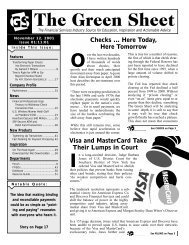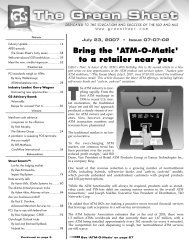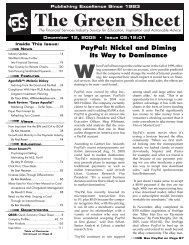View PDF of this issue - The Green Sheet
View PDF of this issue - The Green Sheet
View PDF of this issue - The Green Sheet
Create successful ePaper yourself
Turn your PDF publications into a flip-book with our unique Google optimized e-Paper software.
Effective tradeshow<br />
marketing<br />
By Peggy Bekavac Olson<br />
Strategic Marketing<br />
Although just one component <strong>of</strong> the marketing<br />
mix, tradeshows can drive sales and build<br />
market share in an efficient, effective manner<br />
while building brand equity for your company,<br />
products and services.<br />
With proper event selection, planning and execution,<br />
tradeshows <strong>of</strong>fer a unique and lucrative selling environment<br />
by providing access to a captive audience <strong>of</strong> prospects<br />
under one ro<strong>of</strong>.<br />
Tradeshow experts agree that while attendance may be<br />
lower than in past years, people who attend in <strong>this</strong> down<br />
economy are there with a specific purpose and mission.<br />
<strong>The</strong>y <strong>of</strong>ten plan in advance which exhibits they will<br />
visit, and when they stop at booths, their objective is to<br />
learn and gather information to spur buying decisions.<br />
Attendees' interest is high and their quality and buying<br />
authority is stronger than ever.<br />
Face to face interaction is what makes tradeshows work.<br />
You and your staff have opportunities to meet customers,<br />
key prospects and even potential sales agents and partners<br />
in person. And compared to other selling tactics, you<br />
can show <strong>of</strong>f your organization better and communicate<br />
in a more personal business setting in a tradeshow milieu.<br />
62<br />
Education (continued)<br />
to use tradeshows to support achieving your sales<br />
and revenue targets, to increase company awareness<br />
and sales in a particular industry vertical or<br />
market segment, to launch new products or services,<br />
or to help reach your objectives in terms <strong>of</strong><br />
bringing on new sales representatives, sales agents<br />
or sub-ISOs.<br />
2. Identify and evaluate<br />
Next, identify and evaluate various tradeshows<br />
to assess which ones provide the best opportunity<br />
to achieve the strategy you've defined. Conduct<br />
research to locate the market verticals you'd like to<br />
attack. Talk to your best customers and check out<br />
your competition to see which shows they attend.<br />
<strong>The</strong>n analyze demographics to determine if a particular<br />
event provides a solid target audience for<br />
your efforts.<br />
If building your sales or sales agent team or taking<br />
on sub-ISOs is a big component <strong>of</strong> your annual<br />
strategy, consider exhibiting at the Electronic<br />
Transactions Association's Annual Meeting & Expo,<br />
as well as the quarterly regional acquirers meetings.<br />
If generating merchant leads in a particular market<br />
segment is a top priority, research and attend shows<br />
within those industry verticals.<br />
For example, if you're targeting petroleum and<br />
convenience store merchants, consider exhibiting<br />
at NACStech, which is the Association for<br />
Tradeshows provide attendees a visual way to learn about<br />
your company through your booth display and create<br />
a way to accelerate the sales process by matching prospects',<br />
potential sales representatives', sales agents' and<br />
partners' needs with your company's ability to fill them.<br />
Tradeshows sometimes get a bad rap because they can<br />
be expensive, require significant logistical work, and fail<br />
to generate leads or tangible return on investment (ROI).<br />
This typically occurs when companies participate in<br />
events without mapping out a clear strategy. It's not just<br />
about reserving exhibit space, making travel reservations,<br />
ordering show services and giveaways, and shipping and<br />
setting up the booth.<br />
Steps to success<br />
Having a strategy in place sets your company on the path<br />
<strong>of</strong> making tradeshows a valuable marketing tool. A number<br />
<strong>of</strong> steps must be taken to ensure tradeshow success.<br />
1. Develop strategy<br />
First, define an annual event strategy that supports<br />
your corporate goals. Perhaps you will want<br />
Six key points for tradeshow success<br />
1. Tradeshows <strong>of</strong>fer unique, lucrative selling environments<br />
with access to many prospects in one location,<br />
using personal, face to face interaction to accelerate<br />
the sales process.<br />
2. Tradeshow success is driven by implementing a<br />
clearly defined strategy.<br />
3. Exhibit structures showcase your organization,<br />
build brand awareness and recognition, and create<br />
a favorable impression; they don't need to be large,<br />
lavish and expensive.<br />
4. Spend as much <strong>of</strong> your exhibit dollars and personnel<br />
resources as you can on sales and promotional<br />
efforts at your booth.<br />
5. To justify activities and expenses, define metrics<br />
and measure tradeshow results.<br />
6. Take all aspects <strong>of</strong> exhibiting seriously; your company's<br />
image and reputation are on display.
















